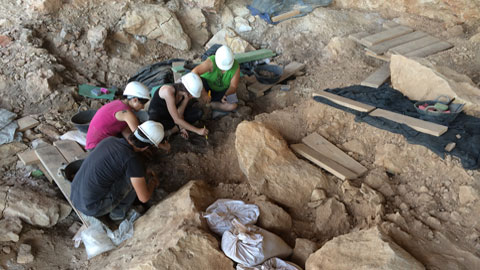Fire for "ritual" purposes found at La Roca dels Bous

25/06/2014
The archaeology team currently digging at the La Roca dels Bous site focuses its research work on trying to explain the purpose of the accumulation of three diameters filled with ashes from some 55,000 years ago. Its large dimensions - over three times as large as the biggest one discovered until now - makes it almost unique in Europe. This fact, added to its concave form and the remains recovered from its interior, makes researchers think that the group of Neanderthals living in the area lit fires for "ritual" purposes, according the directors of the dig, Javier Roda, UAB researcher, and Rafael Mora, UAB professor of Prehistory.
In addition to the ashes from the fire itself, which is over 20 centimetres deep, researchers found different burnt objects which were part of the daily life of the inhabitants, such as bones and lithic objects. Several carbonised faunal remains were located and documented. The remains belonged to species that are not commonly registered, such as carnivores and carrion eating birds, all with marks of having been eaten. The study of the materials, conducted at the facilities of Espai Orígens in Camarasa, will help to obtain data which would confirm "the symbolic activity of these groups is real", according to Roda.
However, Professor Rafael Mora specifies that it is still difficult to determine this fact using scientific methods and that several digging campaigns must be carried out to contrast this data. The excavations, coordinated by the UAB Centre for the Study of Prehistoric Archaeological Heritage (CEPAP), are possible thanks to the technical and economic support of the Department of Culture and Education of the Government of Catalonia, the Ministry for Economy and Competitiveness of the Spanish Government and the Camarasa City Council.
Excavation tasks at the site and in the laboratory, where the morphology of the objects found is catalogued and defined, are carried out by archaeologists and students from different universities of Spain. The team will grow by ten people in July, when work will begin in the Cova Gran de Santa Linya, where archaeologists will also receive the collaboration of a dozen professionals and students from several US universities. The excavation project is also open to the general public through the "Work in process..." programme, where visitors can see all the work that is being done up close. It is a way to disseminate the tasks of archaeologists and explain the importance of preserving and valuing our heritage.
The La Roca dels Bous site, museumised in 2010, can be visited and offers information located on digital tables. This system helps to recreate and show visitors how life was for the Neanderthals, who used this area as a place of passing in their journeys between the plains of Lleida and the Pyrenees mountains. The incorporation of new technologies helps visitors become more familiar with the prehistoric surroundings and with the help of a guide at the end of the visit, they can learn about research methods used in archaeology and discover new details about the first inhabitants of the region.